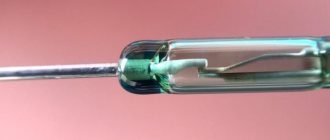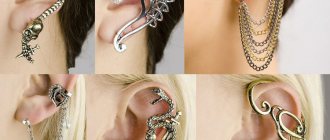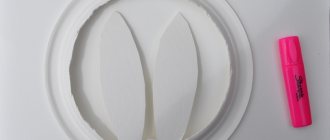The smart nails puzzle is a classic one, consisting of two identical nails.
The gap where the nails intersect is wider than the thickness of the nails themselves, so the nails can be connected to each other as well as separated without the use of force.
The apparent simplicity of this puzzle is what makes it great, and the solution to the puzzle is not as obvious as it seems at first glance.
This tutorial will show you how to shape the nails into the correct shape and, of course, how to solve the puzzle itself.
We make our own geometric puzzles for toddlers and older children.
Content
By the age of 3, children begin to recognize geometric shapes and are able to determine size (large, small) and color. Find similarities and differences between figures. It is at this age that you can offer your child the first geometric puzzle as a game.
Unfortunately, it is very difficult to find material for this age. Either the sets have small parts, or they are difficult for the baby. We suggest making the first puzzle with your own hands. To do this, you can use cardboard, plastic or other suitable material that can be cut into pieces.
Manufacturing
There are so many options for wooden puzzles for children and adults. Next we will look at the most popular and common of them, which are easy to do yourself.
Cross OSS
To make this puzzle, you will need a rail whose width is three times the thickness, for example, if its thickness is 8 mm, then the width should be 24 mm.
The product is made as follows:
- A rail of suitable parameters must be cut into three parts of equal length.
- Next, in each plank you need to cut out a cutout corresponding to its cross section using a jigsaw. As a result, the strips should fit into this hole with little effort. Therefore, it is better for the window to be slightly smaller; in this case, you can bring it to the required parameters using needle files.
- You need to make a cut in the two slats on the side, the width of which should be exactly equal to their thickness. As a result, a T-shaped cut should be obtained in two parts.
- At the end of the work, the parts need to be sanded and varnished.
Assembling the OSS puzzle
This completes the puzzle making process.
Now you need to assemble it by following these steps:
- One of the parts with a T-shaped cutout must be inserted into the window, and it must be advanced so much that the end of the side cutout is “flush” with the surface of the strip.
- Next, you should take the third part and put it on top of the bar with the window until it stops.
- After this, you need to push down the first plank with a T-shaped cut all the way.
As a result, the puzzle takes on the appearance of a single piece.
Crossroads puzzle
Crossroads
To complete this craft, you will need a 1 cm square block.
The instructions for its manufacture are as follows:
- You need to cut three bars about 8-9 centimeters long from the slats.
- In the middle of one of them, you need to make a cutout 1 cm wide so that you end up with a square jumper with sides of 0.5 cm.
- The second part should be made in exactly the same way, only the jumper should turn out not square, but round.
- In the third block you need to cut a groove 0.5 cm deep and wide.
- Then the same block must be rotated 90 degrees, and another similar groove must be made on the adjacent surface.
- Next, all parts should also be sanded and varnished.
Puzzle assembly diagram
This completes the wooden puzzle.
Now it needs to be assembled as follows:
- Holding the block with two grooves vertically, you need to insert a part with a round jumper into it.
- A square puzzle is then inserted into the second slot.
- After this, the block with a round jumper must be rotated 90 degrees counterclockwise, after which the product will take the form of a non-scattering solid figure that is not easy to disassemble.
Note! In order for all the workpieces to turn out to be of high quality, they must be made from dry wood.
Makarov's puzzle
This craft is more complex, so before you start making it, it is advisable to complete a drawing. It must be said that DIY drawings of wooden puzzles do not have to be done to scale with high accuracy. The main thing is to indicate on them all the dimensions in millimeters and the main design features of the product.
Scheme of Makarov's puzzle
To complete the Makarov puzzle you will need the same rail as for the product described above.
It is performed as follows:
- First you need to cut the wooden slats into six equal pieces. One block should be immediately set aside without making any cuts on it.
- On another block you need to make a groove 1 cm wide and 0.5 cm deep.
- On the third block you need to make two grooves. The first is the same as on the previous part, and the second is at a distance of 0.5 cm. It should be the same depth, but twice as wide.
- The remaining three parts are made in the same way - two grooves are made on each of them. The first groove is cut 2 cm wide and 0.5 cm deep. After this, the block must be rotated 90 degrees and, as shown in the diagram, a groove 1 cm wide and 0.5 cm deep must be made.
- Finished parts need to be processed and varnished.
The product is assembled as follows:
- The last two bars need to be folded as shown in the diagram.
- A third block is inserted into the resulting window.
- Next, holding three bars, you need to insert the last sixth bar, as shown in the diagram.
- Then the second block should be turned with the groove up and inserted into the open window “a” formed.
- After this, the block without a cutout is inserted into the window formed between the first two folded parts. After this, the structure will be tightly connected.
It should be noted that without a diagram, it is difficult to assemble this puzzle even for adults.
In the photo - a cube in a cube
Cube in a cube
A cube within a cube is called a carpenter's puzzle, since it is different from all the products described above. This design is a hollow cube with round holes, inside of which there is a small cube. Moreover, it is impossible to pull out the latter.
When you see such a puzzle, the thought comes that the large cube was glued together unnoticed, because otherwise it is impossible to place the cube in it. However, in reality everything is much simpler.
A wooden cube puzzle is made in the following way:
- First of all, you need to cut a cube from a wooden beam with a square cross-section. It must have the correct geometric shape, since the success of the entire operation depends on this.
- Then on each side of the cube you need to mark the center. To do this, draw diagonals.
- Next, a recess of several millimeters is made in the center with a Forsner drill.
- After this, you need to draw a square in the resulting circle. With its help, you can determine the drilling depth at which all circles will intersect.
- Then the workpiece is fixed and a hole is drilled on each side to a previously determined depth. In order not to spoil the part, you should go deeper on each side evenly, turning the cube over and over again.
- As a result, inside the cube you will get a small cube connected by thin partitions to a large one at eight points.
- After this, the partitions must be cut with a knife. Thus, you will get two figures independent from each other.
- Finally, the product must be varnished. The dipping method is usually used for this.
You can play this kind of puzzle on your friends, for example, by inviting them to pull out a small cube for a bet, after all, it somehow got there?
Scheme - hiding cube
Cube-cache
Another interesting puzzle - a wooden cube represents a hiding place. In essence, this is a box that at first glance seems completely inseparable. However, in reality it consists of six parts, not secured to each other by glue or anything else.
Puzzle pieces
To make this design you will need 6 planks 63 mm long, 40 mm wide and 6 mm thick. From these boards you need to cut out three parts with a jigsaw:
| Detail number | Quantity |
| 1 | It forms two walls and a bottom, so it is made in triplicate. |
| 2 | Forms two walls, respectively, is made in two copies. |
| 3 | Serves as a lid and is made in one copy. |
The most important thing in the manufacture of this product is to achieve the most accurate dimensions of all parts. After their manufacture, it is necessary to sand them with sandpaper to obtain a smooth surface.
It should be noted that the manufacture of the third part must be done after assembling all other structural elements. It must be adjusted so that it fits tightly into the groove between elements 1 and 2.
Product assembly diagram
The whole secret of the puzzle lies in element 3, which works like a latch. To disassemble the cache, you need to click on it and slide it inside the cube. If all the parts are made correctly, then when assembled the structure will have no backlashes and is a solid structure.
Miracle Triangle
So, how to make a paper puzzle? Will 4th grade cope with the problem or not? For a child, it is not so important how much a puzzle costs. He will be interested in thinking with you about the task you give him.
Cut out a regular triangle from hard cardboard and ask your child to divide it into 4 sectors so that these parts make a square.
The puzzle has a name - “haberdasher's puzzle”, since the author of the puzzle was the first to cut out such a triangle from a piece of fabric, and then he himself did not know whether the square would form or not. But still, folding a quadrilateral is quite possible.
How to make a haberdasher's puzzle out of paper? It's pretty easy. Using a stencil, draw a triangle on the cardboard and outline it as shown in the picture. This is the solution to the problem.
An adult needs to cut the parts and decorate them with any colored paper to make the parts look more interesting to the child. And then ask your child to assemble first a triangle and then a square from these parts.
Development of useful skills
Modern children's wooden puzzles are the best choice for developing a huge number of skills a child needs.
After all, preschool and primary school age is the most important time when he can receive them. And solving wooden puzzles improves a whole host of skills! This is logical and spatial thinking, intelligence, memory, motor skills of hands and fingers, and much, much more.
Great preparation for school, isn't it? Having laid all these skills at this age, in the future the grown-up son or daughter will be able to use them when entering college and at work.
Montessori puzzle
Montessori is a well-known educational platform used by many parents whose children are homeschooled. If you are familiar with the Montessori method, you know how trusted it is in education.
Lost weight: what Sofia Tarasova sacrificed for the sake of “VIA Gra” (new photos)
Smooth and fresh skin: dermaplaning, or why a woman needs to shave her face
Women's jeans: before you buy them, you need to pay attention to one detail
But even if not, you should check out these great Montessori triangles that will introduce your child to shapes and geometry in general. They are very easy to make and children love to play with them.
Execution technique
Such puzzles for a child can be made in various ways. Let's consider the simplest option. To begin, select a suitable sketch to create the product. Popular options are diagrams with answers in the form of small animals (elephant, snail, cat), as well as in the shape of hearts or stars. This sketch is carefully applied to a wooden plank. Small nails are driven along the contour of the pattern
It is important that they are on the existing contour bends. After this, the aluminum wire is gradually laid along the contour, all ends are well secured
Then you should start creating the removable part. To do this, you need to cut off 2 pieces of wire 15.5 and 14 centimeters long. At the ends of these segments, rings are bent around an iron blank. The longer part is bent so that a figure resembling the letter “P” is obtained. At the end, one part is carefully inserted into the other. The task of this puzzle is to put the resulting removable piece on an animal, star or heart shape.
You can also make a simple puzzle using metal nails with the same diameters. For this we only need two nails. First, their upper parts are bent along with the cap. This is done in such a way that they are at an angle of 90 degrees to the remaining part with the tip. The diameter of the gaps between the parts should be slightly larger than the diameter of the nails themselves. When both parts are completely ready, they should be connected to each other. The point of each nail must be inserted into the gaps. The solution to this puzzle is to separate the elements.
You can make a puzzle in the shape of an anchor. To do this, take a steel wire and cut a piece 30 centimeters long from it. Then prepare a cylindrical metal blank with a diameter of 20 millimeters. A ring is bent on the blank in the middle of the piece, so we get an anchor bracket. Without removing the part from the blank, twist the wire two turns.
Its ends are bent using round nose pliers. This should be done so that you get the “shoulders” of the future anchor. Use another piece of steel material to make the frame. A pair of loops for the rod are bent on it. Anchor claws and horns can be made using discs and nails. The rod does not need to be secured too tightly in the spindle.
You can also make the “Star and Ring” puzzle yourself. To do this, you need to take a thick wooden board and draw 2 circles on it (it is better to use a compass). Their diameters should be 40 and 95 millimeters. Using a protractor, the circles are divided into ten equal sectors, the center is marked on each of them and small nails (3-4 mm in diameter) begin to be driven in there.
As a result, you should have a template in the form of a five-pointed star. All nail heads can be removed using wire cutters. The resulting irregularities should be cut off with a file. A soft aluminum wire is used to go around the contour, this is how the required length of the parts is determined. The base is completely straightened, obtaining the original length for creating the workpiece.
It is important to congratulate a woman on her 55th birthday
You need to cut a small piece from the wire and make “ears” at the ends. Their diameters should be 10 and 20 millimeters. The contour is re-circulated with a metal base. The result will be a star-shaped figure, which is the main part of this puzzle. An earring (30 mm) and a ring (25 mm) at the end can be made from the same wire. The slightly elongated section of the earring should be easily inserted into the ring, into the large “eye”.
How to make a puzzle from two nails with your own hands, watch the video.











